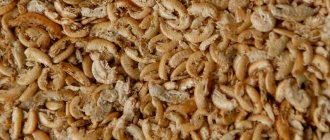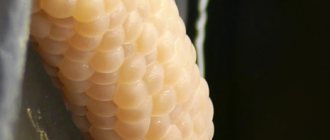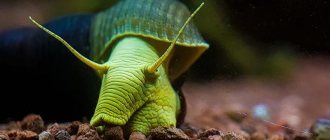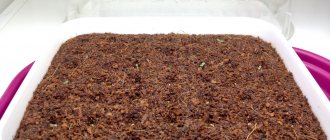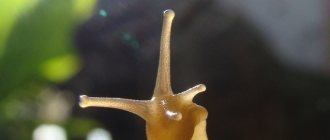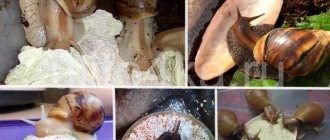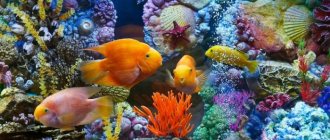Small freshwater crustaceans, gammarus or amphipods, are often used by breeders to feed fish and turtles. These inhabitants of reservoirs live no more than a year, feed on plant foods and are a valuable source of protein for many marine animals. They are caught in brackish and fresh waters. Small crustaceans like to burrow into soil or sand to hide from the scorching sun. The nutritional value of amphipods cannot be denied, but is it possible to buy gammarus for snails without harming the health of the delicate Achatina?
What it is
Gammarus (amphipod, mormysh) belongs to the genus of higher crayfish of the gammarid family of the amphipod order and, in fact, is a small freshwater crustacean. It is used as bait for fishing or as food for turtles, aquarium fish or Achatina snails. The natural habitat of these crustaceans is fresh and brackish waters, where they can be found under stones, in pebbles or coarse sand in the coastal area.
The body of Gammarus is curved in an arc, has a length of about 1 cm and is covered with a chitinous shell consisting of 14 parts. The shade of the chitinous cover can vary from light yellow to brown-green and depends on the diet. Amphipods feed on rotting organic remains of aquatic plants, fallen leaves, as well as the remains of fish and other aquatic inhabitants.
On the head of the crustacean there are two eyes and two pairs of antennae, which are organs of touch and help in searching for food. Amphipods have nine pairs of legs on their bodies, and they move sideways. They breathe with gills.
The lifespan of a gammarus is about one year.
Kinds
Gammarus is not a separate species, but a whole genus. It contains more than 200 species of crustaceans. And the order of amphipods itself has more than 4,500 species. In Russia, the largest number of species, about 270, live in the reservoirs of the Baikal region.
Lake amphipods (barmash or bormysh) live among coastal plants, usually in sedges and reeds. Their body color is gray-green. They are valuable links in the eco-chain of Lake Baikal’s nature. Exceptional fresh water sanitation workers.
Under the stones in the coastal water you can find zulimnogammarus, warty and blue. The first is 2-3 cm long, dark green body with transverse stripes, narrow eyes, antennae equipped with black and yellow rings. The second is 1-1.5 cm in size; the last four segments have very dense bristles. The color is gray-blue.
Amphipods living on sponges are very interesting - parasitic Brandtia, violet and blood-red zulimnogammarus. They feed on other organisms that live on sponges. In the open water of Lake Baikal lives Branitsky's macrogetopoulos; the population calls it "Yur". This is the only pelagic species of freshwater amphipod. That is, not bottom-dwelling, but living in the water column. And a little about amphipods that live in sea waters.
Sand racers are marine amphipods that live near the coast, although they can sometimes be seen in the open sea. The menu of these nimble crustaceans is dominated by carrion, from which they diligently cleanse sea waters, which brings great benefits.
Hordes of these active creatures deal with the huge rotting carcasses of sea animals. Coastal horses live everywhere on seashores where seaweed is thrown up by the surf. They are very noticeable because they tirelessly jump in the air in whole flocks.
There are amphipods that can cause harm to human structures - dams, bridges, dams. This is the clawtail, which is found off the coast of America. It can also be seen on European coasts. It destroys strong structures with small but strong claws, pulling away pebbles to make a cylindrical nest for itself.
Inside it, it clings to the hooks on its paws and holds on. Neptune's horn, another amphipod, is quite large in size; it can grow up to 10 cm. A pair of huge eyes and a translucent body are its features.
Nutritional value as feed
Due to its high nutritional value, gammarus is considered one of the best foods for snails, aquarium fish and turtles. It contains a large amount of carotene and protein, as well as fats and carbohydrates.
Gammarus is a protein supplement for Achatina snails. This feeding is necessary for domestic snails for:
- proper growth and development,
- good functioning of the digestive system and internal organs
- maintaining an optimal balance of chemicals in the body.
If there is not enough protein in the body, this manifests itself in:
- growth slowdown
- deterioration of the condition,
- gnaws appear on the shell and body,
- the snail's leg noticeably loses weight;
- stronger individuals can eat weaker ones.
But it is not advisable to feed your pets only such food. It is necessary to alternate all feeds so that the diet consists of a variety of foods.
What to do if the snail does not eat protein
Find the feeding option that the snail likes best and limit yourself to this option. For example, my snail gets 80% of its animal protein from gammarus.
If the snail doesn’t like anything, then mix the protein in powder form with other supplements - cereals, calcium, or dried herbs. Most often this works. You can also sprinkle protein powder on vegetables or fruits.
And do not forget that protein is not the basis of the diet of Achatina snails.
Purchase and storage
You can purchase gammarus in live, frozen and dried form. Dry gammarus can be found in any pet store, but live or frozen - only at the poultry market. When purchasing dry food, you should pay attention to the expiration date, which should not be more than 12 months from the date of production. Once the package is opened, the food should be used within three months.
If you bought live crustaceans or caught them yourself, you can freeze them, dry them, or leave them alive. To keep live arthropods, you will need a container of water from the reservoir where they were caught. Place the container in a cool, dark place, provide aeration and change a third of the water to fresh water every day.
If you want to feed fresh gammarus to your aquarium fish, keep in mind that live crustaceans can carry fish parasites. To prevent fish from becoming infected, these crustaceans are frozen or ozonated before being used as food.
If you want to freeze crustaceans, wash them well and dry them in the fresh air. They must be frozen in the freezer at a temperature of -20-25 degrees. When frozen, amphipods can be stored for about a year, but it is advisable to feed them to your pets as quickly as possible.
Gammarus can be dried yourself. To do this, use fresh and unspoiled crustaceans. Before drying, they must be immersed in hot water. You should not immerse it in boiling water, since such treatment will lead to the destruction of vitamins and the quality of the feed will deteriorate. Drying should be carried out in a shaded place in the fresh air, spreading the crustaceans in a thin layer on gauze so that air can pass from below and above. You can also use a sieve or stretch cheesecloth over the frame. Amphipods should not be dried in the oven or microwave. Use dried food within 2-3 months if stored in an airtight container.
Note! Gammarus can cause allergies because their chitinous cover contains strong allergens. Therefore, do not allow children to come into contact with such food!
Choosing high-quality gammarus for snails
You can buy crustaceans at any pet store. This can be dried gammarus or briquettes with frozen amphipods. They are sold alive only in special markets, but avid fishermen try to catch the crustaceans themselves. To prevent the living creature from dying, it will have to be kept in the water of its native reservoir. Why is living gammarus not very popular? Its maintenance requires special conditions:
- small aquarium;
- a special dark and cool place;
- aeration (saturation of water with air);
- constant change of water;
- food of plant origin.
Depending on what product the owner buys, the price of gammarus also changes. The feeding is inexpensive, and every shellfish lover can purchase it. You can buy crustaceans by weight, but it is advisable to take them in sealed packages. The shelf life does not exceed 12 months.
On a note! Poor quality food will have a negative impact on your pet's health. Therefore, experienced owners advise taking dried gammarus in transparent bags and only from trusted manufacturers.
Feeding snails with gammarus
To feed snails, you can use whole or crushed gammarus and sprinkle it on vegetables, fruits or herbs. You can also include it in protein-calcium supplements for shellfish.
Gammarus should be fed to snails no more than once every 2-3 days, at a rate of 6-7 dry crustaceans per adult. The number of crustaceans fed depends on age. Place amphipods in a heap in a feeder or sprinkle them on vegetables, herbs and fruits.
This food spoils very quickly in high humidity. Therefore, do not pour in a large number of crustaceans, but remove the half-eaten ones from the terrarium. Do not leave gammarus for more than 12 hours, as your pets may be poisoned by spoiled food.
Instead of gammarus, you can give daphnia to snails. Denmark is also fed 2-3 times a week, 1 teaspoon.
Poisoning and treatment methods
Often purchased dry gammarus is of poor quality. Untreated crustaceans are clogged with grains of sand and infected with parasites, which can seriously harm the sensitive Achatina.
Crawfish poisoning is manifested by the following symptoms:
- leg swells;
- appetite disappears, general lethargy appears;
- The color of the body changes, a lot of mucus is released.
Severe poisoning can be fatal. In such situations, owners are advised to bathe the snail for 30 minutes in a warm solution of water with 4 tablets of activated carbon. Repeat the procedure every 2-3 hours. And then use chamomile decoction as an effective natural antiseptic.
In case of poisoning, dried gammarus should be urgently excluded from the diet of Achatina. At first, keep the clam on baby purees without sugar and salt, as well as on juicy vegetables and fruits. When your pet returns to normal, you can return to normal nutrition, but with high-quality, proven supplements.
Protein poisoning
By feeding gammarus to snails, you can see that they are ready to consume only such food. But everything is good in moderation. Overfeeding snails with protein can lead to poisoning. Therefore, Achatina needs a varied diet, including not only protein foods, but also calcium, fresh vegetables and herbs.
Signs of protein poisoning:
- leg swelling
- lethargy
- lack of appetite
- a large amount of thick and white mucus.
If you fed your pet plenty of gammarus and he developed similar symptoms, for example, the snail became lethargic, began to refuse food and often sleeps, then you should start taking action. Otherwise, death awaits her.
What to feed newborns and small snails
For the first few days after hatching, Achatina snails feed on the shells of their eggs and do not require additional attention. Grown-up babies eat the same things as adults. But to make it easier for them to eat, food is grated or chopped with a knife. It is impossible to feed small Achatina with pureed food: they can suffocate in the loose mass.
Grown-up snails are fed the same foods as adults.
It is important to gradually introduce a variety of delicacies into the diet of small snails in order to form correct eating habits and avoid pathological addiction to a particular product. It's best to start with greens, carrots and apples. The kids' favorite treat is cucumber.
It is necessary to add calcium supplements to food: the need of small Achatina for calcium during the period of intensive growth and shell formation is colossal.
Video: reproduction, laying, how to care for cubs
Why does a snail need protein food?
Without protein, the snail's body will stop growing and developing. Her shell begins to become deformed, becoming scarred and indented, and will eventually stop growing.
The lack of protein affects the general condition of the snail; it loses weight and begins to chew on its own shell and the shells of other snails.
Daphnia should be given to the snail regularly, but in small quantities.
Reproduction and lifespan
Reproduction in temperate latitudes occurs several times during a year of life, in the north - only once. The most active breeding period is the first half of summer. Male contenders fight fiercely for females. The largest male wins.
He jumps on his chosen one and settles on her back, securing himself with his upper paws. They can remain in this position for about a week. All this time the male holds on with the help of his claws. The female molts during the mating process. Her partner helps her in this, using his claws and legs to pull off her old shell.
After a successful moult, the male fertilizes her brood chamber, then leaves the female. She lays eggs in the prepared “room”. There they develop. The crayfish supplies them with oxygen, constantly scooping up water with its legs to its gills, and at the same time to the brood chamber.
The eggs of the crustacean are quite noticeable, dark, there are about 30 of them. Development ends in warm weather after 2-3 weeks, in cold weather – twice as long. Already fully formed individuals emerge from the eggs.
Young crustaceans leave the “nursery” after their first molt. Maturity occurs in 2-3 months. The lifespan of this crustacean is 11-12 months. However, he may not survive such a short period of time. It is actively hunted by fish, amphibians, birds and insects.
